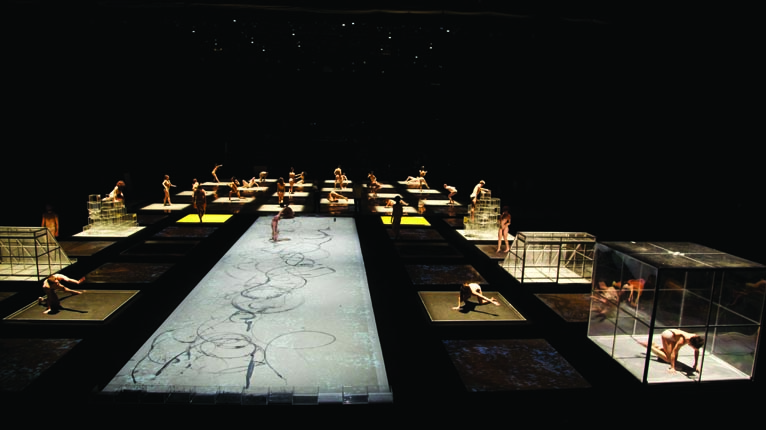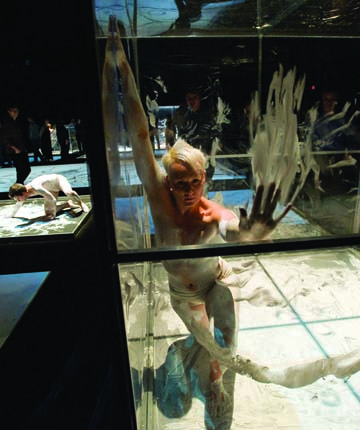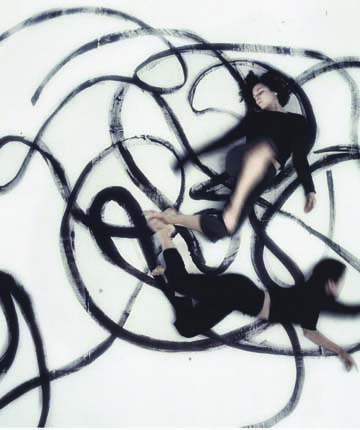EVERYTHING IS CONNECTED: THE “ARMORY TRILOGY” AND SHEN WEI’S DIVIDED UNDIVIDED
| July 20, 2012 | Post In LEAP 15

The Park Avenue Armory has been New York’s “secret art armory” for four or five years now. Every year there are a few unconventional programs of exceptional scale from art world heavy hitters. From Christian Boltanski’s gigantic installation No Man’s Land, to Ariane Mnouchkine’s marathon play Les Éphémères, to Peter Greenaway’s multimedia epic Leonardo’s Last Supper, all projects were created for the Armory’s 55,000 square-feet of unobstructed exhibition space, impossible to reproduce anywhere else. In this way, the Armory entrance also had a certain “Open, Sesame!” effect to it, as the mouth to the treasure trove within. At the end of 2011, the main entrance opened once again, and three grand works in succession were presented to the public: Shen Wei Dance Arts, STREB Extreme Action, and Merce Cunningham Dance Company’s farewell “event.” The three formed a thread of time leaping over half a century, seemingly hinting at New York’s singular “art history complex.” Ever since the 1960s, Cunningham and John Cage have joined forces to liberate the art of dance, all the way up to present day.

1
Obviously, all three choreographers managed to create a scene of grandeur, a certain “spectacle” on which most commentary following the performance seemed to focus. Merce Cunningham Dance Company’s parting performance at the Armory was just like the 800 “events” he conducted during his lifetime: the dances were all derived from fragments of his repertoire. The music and the decor had a randomness to them, and the audience could move around at will, in reflection of Cunningham’s notion of dance as mindful Zen meditation— “I think of dance as a constant transformation of life itself.” The difference with previous “events” lies in scale, this being the largest and most extravagant in history (even though Cunningham passed away two years ago)— three huge stages, numerous “cloud” installations, four musicians’ new commissions, a dozen trumpeters… Even more spectacular is that no longer were there stuffy women griping about where the actual dance is supposed to be; instead, the humongous venue was packed with men and women in formal evening wear squeezed in like sardines, the air heavy with the smell of wine and a sense of ritual. On this last day of the 2011 season, after the event the dance troupes will be dismissed.
Elizabeth Streb celebrated her 62nd birthday during the performance season. She was involved in the tail end of Judson Church’s modern dance movement, and has been active ever since the 1970s. Streb transformed the Armory space into a massive sports field, at the center of which was a shallow pool with trampolines fixed on both sides, complete with huge scaffolding on all sides. Here, the dancers— whom some say were extreme sports athletes, acrobats, gymnasts, or Hollywood stunt people— in the raucous, shouting manner as seen on Band of Brothers, performed all sorts of dangerous tumbles, leaps, climbs, and bungee jumps.
At 40 years old, Shen Wei is the youngest choreographer in this trilogy. From Hunan province, he went to America in 1995, and by 2000 he had risen to international renown. For Shen Wei Dance Arts, Divided, Undivided is the fruit of sixteen-month residency at the Armory. The first half is composed of the pieces Rite of Spring (2003) and Folding (2000) that made his name, the audience response to which was as enthusiastic this time as it was in years past. During intermission they rested for around half an hour. When the audience came back in, the dance floor had already been covered with white LED divided into a 64-section grid. Thirty-two performers lay, nearly naked, throughout half of the space; on the ground of the other half there were drops of every color of oil paint, and beyond, installations of geometrically-shaped pieces of Plexiglas, a tightrope, and human hair. All of the dancing from then on involved bodies interacting with other bodies, with the installations, and with the ground, leaving a painting of sorts on the ground. Amidst all this, LED screens showed views of an electrocardiogram, brain waves, blood vessels, and similar moving images. The biggest surprise was that the audience was invited to take off their shoes to enter the performance space and view the performance at zero distance.

2
Regarding the overall trilogy, as usual the New York Times critics had nothing but praise for Cunningham, even going so far as to give an exhaustive analysis of the cast’s performance during several random segments of the show. But the other two “successors” were not afforded the same patience, as the reviews focused his line of vision only on their external form. Some maintained that aside from “frightening forms,” Streb did not offer anything else worth considering. And as for Shen Wei, his older works had safely passed the test— they had already passed a decade earlier. As for the newer Divided Undivided, its critic offered only that “Scale is not his problem” and that he had created a “spectacle,” and other such safe wording— fundamentally failing to grasp the 60-minute piece as a whole and its particulars. The critic’s understanding of the theme of Divided Undivided was limited to a superficial breakdown into solo dances and group dances and even going so far as likening the multi-person “action painting” to “mass production.”
It is hard to say whether the fog of art history has dulled critics’ sensory organs, but the unthinking masses evidently got more out of these dances than they did. Compared to ordinary viewers, especially to the children and those wearing rain gear gleefully seated in the front row during the Streb’s Hollywood-esque performance, the critics waned depressed; while average audience members were struggling to overcome the discomfort produced by being close enough to touch the half naked performers, the critics were tortured by an anxiety to explain it. For typical formalists, the action painting was immediately reminiscent of Yves Klein, and being close enough to touch the performers likewise recalls Marina Abramovic, leaving them to neatly classify and mentally file away the performance into the dossiers of art history, while disdainfully whispering the reproach of “this has been done before.”
What is interesting is that the most important of the “divided and undivided” happens right between the performers and the audience. In the beginning, the performers quietly lie down to the accompaniment of directionless electronic music. The audience is startled by this unusual scene, hesitating until the conservative among them head to sit down in safer seats and the bolder then take off their shoes and walk into the performance area. Waiting for the audience to draw near, the performers then start to dance within their respective positions. For the performers, being almost completely naked and surrounded close-range by strangers, and with no way to maintain contact with their fellow dancers, is actually an uncommon and challenging experience, and it puts a lot of pressure on them. At this point, the tension in the relationship between the onlookers and the performers represents the so-called “divided” state. As the performers gradually overcome the pressure put on them by the audience in this arrangement, they enter into another state, and the audience also gradually goes from feeling like a strange, external form to having an insider’s perspective and viewing from a deeper layer. Supposing the tension released by the extraordinary performers gradually affects the audience, then the artistic experience happens during the process of being “undivided.”
This is where Shen Wei’s intends to break down the traditional separation between the audience’s seats and the stage. Contrary to the “spectacle” on which the media so likes to dwell, Shen’s is an endeavor to create an incomparably intimate feeling in this incomparably vast space. Were it not for the audience being too large, he would more or less succeed. Instead, a pity: to a large extent, having the crowd flowing freely through the cramped passageways between the 64 grids erodes the feelings of one-on-one intimacy and immersion. Of course, allowing the audience to enter the designated performance area is a game of chance, with no consideration of the potential success or failure. But in the eyes of the audience members who refuse to enter the space, both sides are actually “undivided” from beginning to end— and yet this kind of looking on may be considered just another method of viewing.
By comparison, the intimacy of the last part of the performance is no accident. This happens after the main solo dance, the pas de deux, and the group dance. All of the performers stand in their original positions, still as can be, as the music vanishes. Only the sound of heavy breathing can be heard. The collective sound of 32 people breathing captures the audience, the space between each inhalation and exhalation producing a mysterious resonance. After this the lights are suddenly extinguished, and everyone is left standing in darkness, absolutely still, all falling subconsciously into one single breathing pattern. The lights then come back on, the performance finishes. Some audience members feel a sense of pleasure at the extraordinary thing they merged together to create, even a sense of joy. And this sense of joy is born, without a doubt, from a relatively profound sense of being “undivided.” To take it a bit further and it would be closer to a religious experience than an aesthetic one.

3
Another layer of the “divided and undivided” is manifested in body movement. For the last half-century, the contemporary arts have been fractured by revolutions. Cage freed music, and Cunningham let dance return to the movement of the body, the greatest significance of which lies in all the possibilities it opened for the century to follow. “Dance for dance’s sake” has become mainstream in America over the last few decades. Dance has cast off narrative and subjective emotion, and its traditional dependence on the structure of music. In parallel developments in other areas, at this point avant-garde music already has people worrying that the liberation of sounds has not yet brought about a comprehensive freedom, and that the possibility of music to purely create music from sound is already in the process of being exploited. As for the visual arts, people have also discovered that while sociocultural background and technological means tend toward uniformity, postmodern art has become homogenized. And what about avant-garde dance? How much further can “movement research” into the abstract noumenon of the body still go?
One might as well treat this “Park Avenue Trilogy” as three case studies on the subject. Examining in detail the “extreme action” of Streb’s thoroughly American-action-flick spirit, each part of the performance is a foray into the internal and external strength of the human body. After each segment, the big screen flashed a manuscript revealing Streb’s “scientific” study of gravity, elasticity, resistance, endurance, balance, mathematical modeling, and so on. Consequently, she also calls her own dance “action art.” Even though there are certainly people who challenge Streb’s turning dance into athletics— “Look, she dropped down from the flying rings again!”— she is, after all, still considered an exotic and intriguing novelty in the study of human kinetics. People are the vehicle for the movement of the body, and in the end they are but people. By coincidence, if one takes Streb’s movements as the essence of the typical American superman, then Shen Wei’s tend toward the Eastern extreme.
Shen Wei’s contribution to dance is known as the system of “natural body development.” The introductory piece at the Armory, the older Rite of Spring, is an extremely good example. For it, Shen Wei developed 14 different ways of moving the body, corresponding to the 14 movements Stravinsky’s devastating Rite of Spring, which was composed between the two World Wars. After an enormous act of will power to resist the temptations of emotion and narrative— in contrast to the emotion and theatrical force of Vaslav Nijinsky and Pina Bausch’s Rite of Spring— Shen Wei achieved a completely post-abstract freedom. In line with Lao Tzu’s claim that “the universe is not benevolent, all living things are the same,” the human body reveals an aesthetic appreciation of vegetation: the fine twitch of a nerve, the lateral movement of a joint, pliant litheness— all like the divine, intoxicated gyrations of the legendary imperial concubine Yang Guifei. The formation of the performers and the complex subtlety of the changes in movement during their battle are refreshing compositions of time and space. The music and the dance have nothing to do with the chaos of Cunningham’s works, nor with George Balanchine’s belief that music is the dancer’s floor, but rather, they melt in and out of another, exposing the dialogue between dancers and musicians. Shen Wei’s Rite of Spring is a step forward for “dance for dance’s sake.”
In later works to follow in this vein, Shen Wei’s cultural gene seemed to play an even bigger role. His explorations of the human body began to depart from Asian culture, such as in Atlas, which was based on the music of Steve Reich, or the first time he used “action painting” in Connect Transfer. Other examples include his Re: trilogy about Tibet, Angkor Wat, and the Silk Road in China, all exploring in succession the human body’s coordination, internal forces, breathing, qi, and meditation, paying particular attention to the human body in accordance with natural laws of motion, as well as to the boundaries of the theory of harmony between man and nature. This thereby formed a contrast with Cunningham’s unnatural approach of utilizing computer choreography and people imitating robots. Can the possibilities of pure study of the choreography of the human body be exhausted? It looks like they cannot, because a person is an embodiment of the spirit of the universe’s most exquisite and complex divine force, and the spirit of the universe is infinite.
Divided Undivided is also an investigation of the relationship between brain and body. In the first half of the performance the performers move with total control of their bodies, without even thinking; in the second half an electroencephalogram appears on the LED floor, and the performers shift gears, now using their brains to control their bodies. With no way to rely on the music (it has no rhythm), completely relying on memory and the brain’s feedback, the performers carry out corresponding movements according to a rhythm formulated in advance: “head to 7, tongue to 9, knee to 4C; shoulder to C2, two beats; buttocks to A8, half-beat…” The choreographer is testing the performers’ command of their bodies and the break down of the bodies; the performers sense the difficulty of the human body being both “divided and undivided,” and must accept the challenge of overcoming the brain’s inability to shift gears.
Like Streb, Shen also explored the influence of external forces on the movements of the human body in Divided Undivided. This happens during the middle of the performance. One after another, dancers leave their own spot on the grid, heading towards the others’ places— symbolizing the external world. They dance within a giant spring, exploring the relationship between the pull of the external and the internal; they dance in a glass box, exploring the difference between what the body perceives and what the eyes perceive, watching the movements in response to an illusion; they dance on a glass slope, experimenting with the body’s ability to contend with gravity…
What is fascinating is that this section resonated intensely with the audience, and moreover, that what every person saw and felt was different: there were those who saw the male dancer in the glass box and when he encountered a solid wall, experienced his frustrated struggle; there were others who saw “Sisyphus” struggling over and over up the slope only to slide down again; some saw two people dancing suggestively in unison as if making love, while also scanning the rest of the crowd, as if having group sex. Shen Wei said afterwards that he had not yet considered any of these possibilities, but that the audience’s interpretations were all correct; for example, when the performers explored the kinetic relationship two bodies joined at the middle, people had no trouble associating this action with sex, or riding a horse, or even riding a bike.
Therefore, performers, audience, and the transmission and receipt of information, all “undivided” in one peculiar way. Half a century ago Cage absorbed the principles of Zen and I Ching, learning to treat music as simply part of the din of the world, and taking it upon himself to use art to imitate nature, thus expecting the audience not to passively receive art, but rather, to pour its own meaning into the receptacle that is art. The demands made of the audience, as the belief that their understanding and participation play a crucial role, recalls Cunningham’s regular abandoning of existing repertory in favor of “events.” Shen Wei’s understanding seems more instinctual, and also more Eastern: “everything is connected, in a way that we know or we don’t know.”

